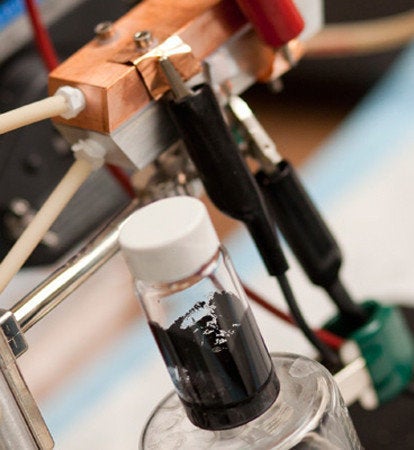
The brainy folks over at MIT, who’ve brought us all sorts of cool cleantech stuff, now have another one to add to the list: a self-proclaimed “significant advance in battery architecture” that “could be a breakthrough for electric vehicles and grid storage.” Ok, that sounds good – we’ll bite to see what they are talking about.
This breakthrough, as MIT puts it, “relies on an innovative architecture called a semi-solid flow cell, in which solid particles are suspended in a carrier liquid and pumped through the system. In this design, the battery’s active components — the positive and negative electrodes, or cathodes and anodes — are composed of particles suspended in a liquid electrolyte. These two different suspensions are pumped through systems separated by a filter, such as a thin porous membrane.”
The new design, created by MIT graduate students and professors, is said to separate “the two functions of the battery — storing energy until it is needed, and discharging that energy when it needs to be used — into separate physical structures.” It is this separation that reportedly means batteries can be designed more efficiently. Also, because the new semi-solid flow battery design in some ways looks and flows “like black goo and could end up used in place of petroleum for transportation,” it is being called “Cambridge crude” by those involved.
A variety of potential advantages, according to MIT, are seen in this battery design. These include reducing the the size and the cost of a complete battery system, including all of its structural support and connectors, to about half the current levels; permitting, in EV applications, the possibility of ’refueling’ by pumping out the liquid slurry and pumping in a fresh, fully charged replacement or quickly swapping out the tanks; and, for energy storage applications, allowing for large scale, clean energy storage at what is said to be low costs.
Yury Gogotsi, director of Drexel University’s Nanotechnology Institute, commented on the creation of this battery to MIT, saying “the demonstration of a semi-solid lithium-ion battery is a major breakthrough that shows that slurry-type active materials can be used for storing electrical energy. This advance has tremendous importance for the future of energy production and storage.”
One of the MIT professors involved with the project, Yet-Ming Chiang, should be well known to followers of energy storage news. His previous work on lithium-ion battery chemistries led to the 2001 founding of MIT spinoff A123 Systems. The technology developed under his watch in this new case is being licensed to a company called 24M Technologies, founded by him and others last year.
Funding for MIT’s battery breakthrough was provided, in part, by grants from the U.S. Department of Defense’s Defense Advanced Research Projects Agency and Advanced Research Projects Agency – Energy (ARPA-E). EarthTechling attended an ARPA-E conference earlier this year, noting the advances universities and early stage companies were making in cleantech advancement with help from ARPA-E and the U.S. Department of Energy. This looks to be just the latest case of this innovative public-private partnership.